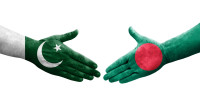Opinion
Course in diplomacy
In the multipolar world that emerged after the end of the Cold War, rivalries have been shaped by diplomatic initiatives to protect and promote national interests.
Maxence Castiello
In the multipolar world that emerged after the end of the Cold War, rivalries have been shaped by diplomatic initiatives to protect and promote national interests. In this changing context, states must define a precise diplomatic agenda in order to ensure their political independence and economic development. However, Nepal has lacked a consistent foreign policy over the past decades; and to resolve this problem, political and academic experts gathered at the Nepal Foreign Policy Conference to define foreign policy outlines for the country.
Organised by the Asian Institute of Diplomacy and International Affairs, the meeting consisted of diverse thematic sessions to revisit Nepal’s foreign policy and discuss major geopolitical issues. The one-day event was inaugurated by three former ministers—Ramesh Nath Pandey, Madhukar SJB Rana and Surendra Pandey—and brought together more than 25 speakers and 250 other participants.
Economic nationalism
A clear foreign policy vision is inseparable from domestic issues. National diplomacy should not be guided by political considerations as the national interest remains independent of political changes. Nevertheless, Dr Khadga KC pointed out that, in a changing global context, developmental diplomacy should also be a priority alongside the country’s sovereignty. Indeed, a nation’s pursuit of prosperity requires economic nationalism that must be integrated in its geo-economic policy design.
Soft protectionism can be another tool for the makers of foreign policy as was demonstrated in the past by South Korea and China. The first was able to combine soft protectionism with a realistic but accurate public investment plan to become one of the most advanced economies in the world. Meanwhile, China has been able to put aside its ideological orientations in favour of the concept of realpolitik by finding an ally in the US. The country has behaved according to its own interests, as evidenced by the accession to the position of a permanent member of the UN Security Council.
Nepal should take inspiration from these examples by giving precedence to its national interest. The world is moving eastwards as the economic centre of gravity is shifting towards Asia, and Nepal can be established as a gateway state. This phenomenon, boosted by two great powers, China and India, represents a true opportunity for Nepal’s development. The country needs to clearly define its role as a buffer state and maintain balanced relations with its two giant neighbours.
Bridge between giants
While it is necessary for Nepal to maintain relations with China in order to soften its dependence on India, it should not threaten the security of its two neighbours; but assert itself as a transit country, or as postulated by Dr Yubaraj Sangraula, as a ‘bridge country’. To this end, connectivity projects and initiatives, like the creation of a trilateral economic corridor, should be encouraged. The idea of a China-Nepal-India Economic Corridor could help to reinforce cooperation between the two giant countries.
Nepal’s lack of involvement in regional and international organisations hinders the fulfilment of development goals. This failure in Nepal’s diplomacy and its relative isolation on the international front can explain the lack of international support during the 2015 blockade by India. Experts blame this partly on a lethargic attitude and the failure of the South Asian Association for Regional Cooperation (Saarc) based in Kathmandu. The future of this regional organisation has been questioned as it consists of South Asian countries with the highest growth rates in the world. South Asia is one of the least integrated regions in the world, and it has missed out on strong economic and trade opportunities.
Regional cooperation must be strengthened through this organisation or through bilateral or trilateral initiatives. This lack of dynamism is an example of Nepal’s under-involvement in the international sphere. Nepal should enhance its commitments in bilateral and multilateral relations by respecting the precepts of the Non-Aligned Movement. These principles are consistent with the country’s historical attitude towards every international issue. The essence of non-alignment is compatible with the Himalayan nation’s international relations that are based on merit and demerit.
Nepal’s relations with labour destination countries remain tense despite being dependent on remittance. This financial flow, which represents around 30 percent of the annual GDP, is considered to be one of the major financial resources for the country’s development. If remittance is crucial for Nepal’s economic growth, the government should accord priority to the welfare of the migrant workers who face insecurity, uncertainty and deplorable living conditions. Despite the existence of laws, Nepali migrants suffer from abuse, exploitation and financial distress. Government efforts should be concentrated on implementing and ensuring migrant workers’ rights as per the Foreign Employment Policy 2012.
Nepal must also reinforce its diplomatic actions by concluding bilateral labour agreements with the destination countries. By involving international organisations and strengthening the capability of diplomatic representatives, Nepal should be able to save the dignity of its citizens abroad. Nepal has definitely suffered due to the lack of a clear and continuous foreign policy. The conference has provided guiding principles for the country’s diplomacy that should be shaped in favour of the national interest, regional cooperation and mutual confidence.
Castiello is a research intern at the Asian Institute of Diplomacy and International Affairs




 8.12°C Kathmandu
8.12°C Kathmandu










